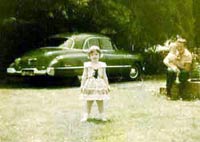My dad traded
the 1939 Buick Super on this car, which was bought new at about $2,700. Dad was
pleased to say he got more in trade for the '39 ($685) than he paid for it when
he bought it used in 1941 ($675).
My actual on-road driving experience
started in the '49 car. Everyone made fun of it because of its Dynaflo transmission
and the roar of the engine the car eventually caught up to, and because of the
Cruiserline Ventiports on the front fenders.
Once I had some confidence,
I made it go over 90 MPH on the piece of road that still runs through the Mobil
refinery on Crenshaw, south of 190th Street in Torrance, near Los Angeles.
There was a favorite hill on the south side of Palos Verdes,
an unpaved, one-car-wide path among some trees and
|
"Put the foot down and steered..." | brush.
It was steep enough that a person on foot had to grasp at the vegetation to keep
from sliding or tumbling down. To drive to the top of that thing was a challenge
not many contemporary cars (well, those available to my friends and I) could meet.
I took the Buick to the top in one calculated rush, notable for a lack
of drama. Put the foot down and steered, and my four or five passengers held their
breath. Bwwaaaaaaaaaa, to the top.
The hard part was backing down: no
place to turn around at the top. And in the dark.
No one who knew ever
made fun of it again.
One spring vacation my parents went to San
Francisco, leaving 16-year-old me at home with the admonition that I not do anything
foolish. Uh huh. In those days Balboa Island was the Spring Break ground zero.
My friends and I cruised down there in the Buick, to where surface of the world
space was hard to find, let alone parking for a Buick.
We made innumerable
laps around the island, in and out of streets and alleys. Suddenly, as we turned
out of an alley we saw a car trying to pull out of a place. Unfortunately there
was a car between us and it. That car could not back up to let the parked car
out unless we moved.
|
"...shifted to Reverse, backed up..." |
I debated for an instant, knowing if we sat still, both the others would
have to stay where they were. The car in front of us could drive
on by and let the parked car out, thereby awarding us the prize; however, my sense
of fair play (still the norm and very active in those times) dictated that I yield
to the driver ahead, who was after all there first.
So I looked in the
mirror, saw it was clear, looked down and shifted to Reverse, backed up... Into
the front of a VW that had in that split instant whipped out of the alley and
into my path. Crash.
VWs had only been in the States for a couple years
at that point. They still had the glass covers over the headlights. This example
also had a bumper overrider bar on the front. For all the good it did, what with
the Buick nose-down under reverse acceleration, the VW nose down under braking.
The bill was $92 and something for a whole new VW hood, and a pair of
headlamps from the bucket out. The VW was white, and was driven by a 16-year-old
girl. Her daddy was a ceramicist. The car was used to deliver his product to dentists.
It was supposed to be in Long Beach, not on Balboa Island. Just after the crash,
as we were picking up pieces of glass off the street, she was dripping tears off
the end of her nose, and she said, "S**t."
The Buick was in our family
during some memorable times, including
|
"...let me trade it in on the MG..." |
several of the annual trips to Tijuana,
Mexico, and during most of my
learn-to-date experiences, and literally hundreds of miles at slow speeds,
traveling all over Southern California's relatively freeway-free landscape,
looking, laughing, judging the world, smiling, and otherwise philosophizing
with friends.
In 1957 my parents let me trade it in on the MG TD pictured on my web site "Home"
page.
The salesman said he usually allowed a nickel a pound for Buick
trade-ins. He was kidding. It actually worked out to be a total of $90, about
15% of the MG's price. I don't know how much that is per pound.
In 1970 or so I was promoting some Tijuana Beach road races. One of
|
"...Jim Clark driving him and Gurney..." |
the people I met was Walt Walsh. He drove a '49 Roadmaster, gray. It all worked
good, and he said he had it from new. He is the man who convinced Dan Gurney to
campaign among the English racers to bring their rear-engine cars to Indy. He
told a good story about Jim Clark driving him and Gurney and Graham Hill around
the oval at the top speed of a Ford rental car, talking about his sheep and the
heather in Scotland, as the tires squealed and the wind whistled through the car.
|

